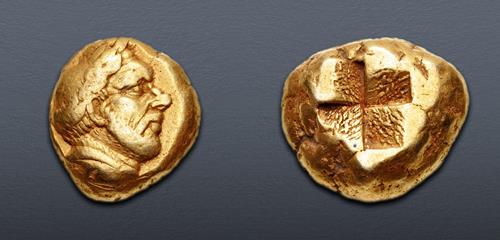|
MYSIA, Kyzikos. Circa 450-330 BC. EL Stater (17mm, 15.91 g). Bearded head of Timotheos right, wearing laurel wreath; [below, tunny right] / Quadripartite incuse square. Von Fritze I 197; Greenwell 81; Boston MFA 1561 = Warren 1500; SNG BN 337; SNG von Aulock –; ACGC 965; Dewing –; Gillet –; Gulbenkian –; Jameson 2207 = Pozzi 2177; Kraay & Hirmer 721; Rosen –. Lightly toned. VF. Well centered on a compact flan.
Ex JTB Collection (Triton XXIII, 14 January 2020), lot 317; Marti Hervera and Soler & Llach 1090 (25 February 2016), lot 21; Marti Hervera and Soler & Llach 1088 (15 October 2015), lot 29.
J.P. Six (NC 1898, pp. 197-198) first suggested that the bearded male portrait on this stater was that of the Athenian general Timotheos (d. 354 BC), who had raised the siege of Kyzikos in 363 BC (Diod. Sic. 15.81.6), noting a similarity between the coins and a marble portrait in the Capitoline Museum (no. 46). Other authors subsequently took different views. However, in "The Cyzicenes: A Reappraisal," AJN 5-6 [1993-1994], pp. 9-11, Mildenberg defended Six's hypothesis. He noted that Kyzikos was under Persian control from 540 BC until 445 BC, and then from 387 BC until the end of the Achaemenid Empire. During the almost sixty year interval, Kyzikos was allied with Athens as a member of the Delian League. Kyzikos, however, was not banned from continuing to strike electrum staters (per League rules), because Athens saw the coinage as a valuable means of payment and in its best interest. Thus, when Athenian forces under the command of Timotheos successfully raised the Persian siege of Kyzikos in 363 BC (Diod. Sic. 15.81.6), the citizens placed the portrait of the victorious general, complete with laurel wreath, on this issue of staters to show their appreciation of his services and subtly honor him in an already-accepted Athenian associated context.
Timotheos was the son of Konon and a Thracian mother (Ath. 13.577a). A prominent citizen, Timotheos was an associate of both the philosopher Plato and the Athenian orator Isokrates. Between 378 BC and 356 BC, he frequently served as strategos, in which capacity he was able to secure an Athenian alliance with Kephallenia, and friendship with the Akarnanians and the Molossians. In 373 BC, he was assigned command of a fleet to relieve Korkyra from Spartan control. Because the expedition was underfunded, the relief was delayed, prompting Timotheos to be brought to trial. Through the intervention of his allies, including Jason, the ruler of Pherai and the tagos (ταγός) of the Thessalian League, Timotheos was acquitted. Following his acquittal, and with the assistance of Amyntas III of Macedon, Timotheos took Korkyra (Diod. Sic. 15.47). For this, a statue was raised in his honor in Athens (Aeschin. In Ctes. 243). In 363 BC, Timotheos raised the siege of Kyzikos, for which these staters may have been issued (Diod. Sic. 15.81.6). In 366 BC, Timotheos was sent to aid Ariobarzanes, the satrap of Phrygia, but when he discovered that the satrap was in revolt against the Great King, Timotheos turned his attention to the northern Aegean. There, he captured Samos after a siege of 10 months, followed by similar conquests along the Thraco-Macedonian coast. A legal action brought against him by Apollodoros (the speech of which is attributed to Demosthenes), is noteworthy for illustrating the reversal of fortune of the once-great and honored general. Timotheos was once again in command during the Social War (357-355 BC), but competing personalities among the leadership again brought Timotheos to trial. Found guilty and unable to pay the heavy fine imposed on him, Timotheos retreated to Chalkis in Euboia, where he died. In remorse for their treatment of the once-favored general, the Athenians forgave a greater part of the debt that had passed on to his son, Konon. They also brought his ashes back to Athens, burying them in the Keramikos and erecting statues to him in the Agora and on the Akropolis.
The final winners of all Triton XXV lots will be determined at the live public sale that will be held on 11-12 January 2022. Triton XXV – Session One – Greek Coinage (Part 1) will be held Tuesday morning, 11 January 2022 beginning at 9:00 AM ET.
Winning bids are subject to a 20% buyer's fee for bids placed on this website and 22.50% for all others.
We recognize that our users may have various Internet Browsers and Operating Systems. We like our visitors to have the best possible experience when using our bidding platform. However, we do recognize that it is impossible to develop applications that work identically, efficiently and effectively on all web browsers. The CNG bidding platform supports the latest stable major version and the stable previous version of Mozilla Firefox and Chrome.
|
